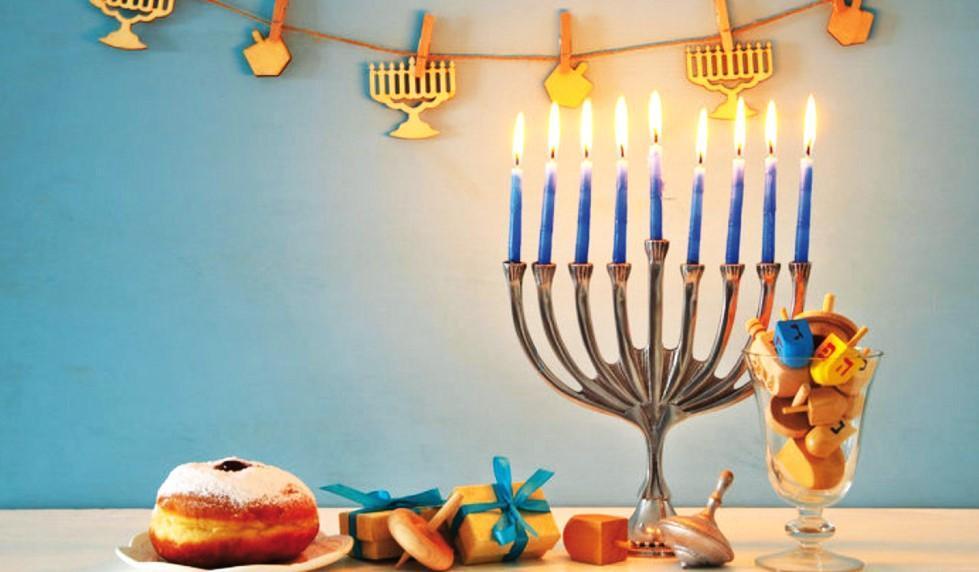Fried fritters and eternal light

Today is the last day of the festival lights, to light the last candle of Hanukkah. In origin, the light was not that of a candle, but an oil lamp, which is named “kandil” in the Turkish language, naturally having connections with the word candle, through Arabic and Latin connections. The miracle of oil is the whole idea behind lighting the candles one by one each day, for eight days and nights, to pay homage to the miracle of oil that lasted to illuminate the Temple for eight days. That is why the candelabrum for the menorah for this period is nine-branched, one branch reserved as the source of light to ignite the others.
The menorah special for the festival of lights is usually called hanukkiah, and the word menorah has interesting etymological and contextual connections with minaret, the architectural element of a mosque used for calling to prayer. The Arabic word for light is “noor/nour,” which comes from the Semitic stem “n-w-r,” or from the Aramaic and Syriac word “nūr,” meaning fire. Minaret, or “minare” in Turkish, actually means lighthouse or tower and comes from the Arabic word “manāra” and in Turkish Islamic architecture, the minarets are always illuminated with lights at night and especially the holy nights of Kandil, hence the name related to candelabra or candle. The same root is used in the menorah, meaning a candelabra, both bearing the meaning of one that gives light and shines, both literally and ideologically. This explains the linguistic relation between two symbols: The Jewish menorah and the Islamic minaret, they both bear spiritual light.
The story behind the reason for lighting candles dates back to 200 B.C., when Judea became part of the Seleucid Empire of Syria. Jews were allowed to practice their religion, as King Antiochus III the Great wanted to conciliate his new Jewish subjects. The King guaranteed the Jews their right to live according to their ancestral customs and to continue to practice their religion in the Temple of Jerusalem. However, when Hellenized Jews became in charge in Judea, there was a conflict with traditionalists, and religious practices were prohibited, and the Temple was polluted with various unacceptable incidents, such as sacrificing pigs at the altar. When the Temple was liberated once again, it had to be cleansed from such improper remains, but when the traditionalist Jews re-entered the Temple on the 25th day of the month Kislev, they found only one jar of pure oil, enough to be lit for only a single day. They needed at least eight days to produce pure oil by pressing olives, but a miracle happened and that single jar of oil lasted for eight full days until the newly pressed pure oil became ready. That is why the oil and oil lamps have a symbolic value in Hanukkah, and this is the reason behind eating lots of fried food during the period of the festival of lights.
The oil-fried specialties of Hanukkah days seem to be mentioned mostly as potato latkes and sufganiyot, aka fried round doughnuts, but the very original specialties must have been quite different. These are more tastes of the Ashkenazi Jews living in Eastern and Central European countries. Bimuelos or buñuelo is a Sephardic version. Interestingly such fried spherical yeast dough fritters are also much-popular during the Carnival time before Lent by Christian communities, and during the “Arife” day, just before Ramadan by Muslims in this country. The Turkish tradition of making dough fritters on special days, and especially after the deceased, goes back to Central Asian roots, where according to shamanistic beliefs, such foods carried the aromas of frying accompanying the soul of the deceased up in the sky to the eternal journey, and when the souls of the loved ones revisited their homes on special days, or at the anniversary of the day of the death, they saw that the chimney is still piping with fumes of fried foods, the family is well and tight, the home is keeping the life going.
Turkish cuisine is rich in such fried foods, both sweet and savory, some having such symbolic annotations. The answer for potato latkes can well be “Mücver” of any sort, a generic name used for vegetable fritters. Nowadays, the zucchini version is the most popular one, but in the past mücver could be of any vegetable. Remembering that potato was a novelty that came to Europe only after the discovery of the Americas, a veggie-based mücver could be a much better choice, keeping in mind that recipes often include brined salty white cheese, another ingredient that has to be in Hanukkah tastes, but often remains forgotten. The reason why cheese has a crucial role is because of Judith’s miraculous act of defeating Holofernes, the ruthless Greek general. The courageous woman made a plan to seduce and kill the general, served him copious amounts of wine and cheese, the salty cheese making him thirsty and quenching his thirst for more wine, eventually dosing him off to his final sleep. Beheading the general, Judith liberated her fellow Jewish brethren. So, cheese-laden, oil fried mücver varieties are just right for Hanukkah as a local taste here, and for a sweet taste, I can suggest cheese-filled kadayıf sweet künefe, a perfect alternative dessert, fit at least in context to the meaning of Hanukkah.












